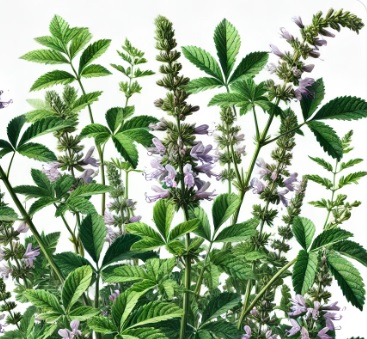Glycyrrhiza uralensis, commonly known as Ural Licorice, is a perennial herbaceous plant native to the regions of China, Mongolia, and Russia. This plant is widely recognized for its medicinal properties and is a key ingredient in traditional Chinese medicine. The plant is known for its sweet-tasting roots, which are used both as a flavoring and for their therapeutic benefits.
Botanical Classification:
Kingdom: Plantae
Order: Fabales
Family: Fabaceae
Genus: Glycyrrhiza
Species: Glycyrrhiza uralensis
Plant Characteristics:
Glycyrrhiza uralensis is characterized by:
Flowers: The plant produces small, pea-like flowers that are typically purple or blue, arranged in dense clusters. These flowers bloom from late spring to early summer.
Foliage: It has pinnate leaves with oval leaflets. The leaves are alternate and have a glossy green appearance.
Roots: The plant is particularly noted for its thick, fleshy roots, which are the primary source of its medicinal properties. The roots are brownish and have a sweet taste.
Growth Habit: A perennial herb that grows up to 1.2 meters in height. It has a spreading root system that helps in soil stabilization.
Soil and Light: Prefers well-drained, sandy soils and full sunlight but can tolerate partial shade. It is adaptable to various soil types and climatic conditions.
Chemical Composition and Structure:
The chemical composition of Glycyrrhiza uralensis includes:
Glycyrrhizin: The primary active compound, known for its sweet taste and significant medicinal properties. It has anti-inflammatory, antiviral, and immunomodulatory effects.
Flavonoids: Includes compounds like liquiritin and isoliquiritin, which have antioxidant and anti-inflammatory properties.
Saponins: Present in the plant, contributing to its potential health benefits and therapeutic effects.
Essential Oils: Contain various bioactive compounds that contribute to the plant's overall medicinal properties.
Uses and Benefits:
Medicinal: Glycyrrhiza uralensis is used in traditional Chinese medicine to treat various conditions, including respiratory issues, digestive problems, and adrenal insufficiency. It is known for its ability to soothe coughs, reduce inflammation, and support gastrointestinal health.
Cosmetic: Extracts from the root are used in skincare products for their soothing, anti-inflammatory, and skin-brightening properties.
Flavoring: The root is used as a natural sweetener in various food products and traditional sweets due to its distinctive sweet taste.
Applications:
Medicinal: Utilized in herbal supplements and traditional medicine for its therapeutic benefits, including anti-inflammatory, antiviral, and digestive support properties.
Cosmetics: Incorporated into skincare formulations for its soothing, anti-inflammatory, and brightening effects.
Food Industry: Used as a natural sweetener and flavor enhancer in food products and confectioneries.
Environmental and Safety Considerations:
Environmental Impact: Glycyrrhiza uralensis is generally considered to have a low environmental impact. It is a non-invasive species and is cultivated in controlled conditions to prevent overharvesting of wild populations.
Safety: Generally considered safe when used in appropriate amounts for medicinal or cosmetic purposes. However, excessive consumption or use of Glycyrrhiza uralensis can lead to side effects such as hypertension and electrolyte imbalances. Individuals with pre-existing health conditions or those on medication should consult a healthcare provider before use.
INCI:
Skin conditioning agent - Emollient. Emollients have the characteristic of enhancing the skin barrier through a source of exogenous lipids that adhere to the skin, improving barrier properties by filling gaps in intercorneocyte clusters to improve hydration while protecting against inflammation. In practice, they have the ability to create a barrier that prevents transepidermal water loss. Emollients are described as degreasing or refreshing additives that improve the lipid content of the upper layers of the skin by preventing degreasing and drying of the skin. The problem with emollients is that many have a strong lipophilic character and are identified as occlusive ingredients; they are oily and fatty materials that remain on the skin surface and reduce transepidermal water loss. In cosmetics, emollients and moisturisers are often considered synonymous with humectants and occlusives.
Skin conditioning agent. It is the mainstay of topical skin treatment as it has the function of restoring, increasing or improving skin tolerance to external factors, including melanocyte tolerance. The most important function of the conditioning agent is to prevent skin dehydration, but the subject is rather complex and involves emollients and humectants that can be added in the formulation.
Synonyms:
CAS: 94349-91-4 EC number 305-209-3
![]() Chinese Licorice
Chinese Licorice 
